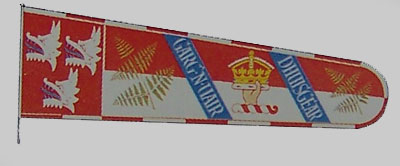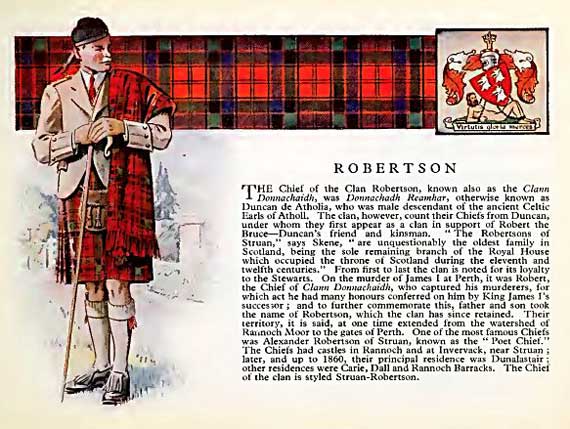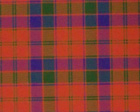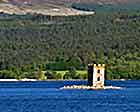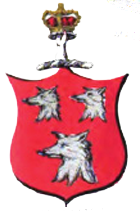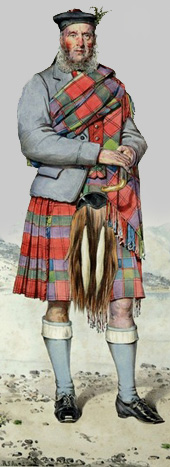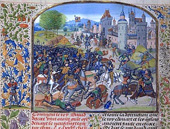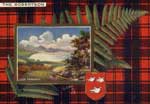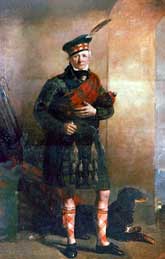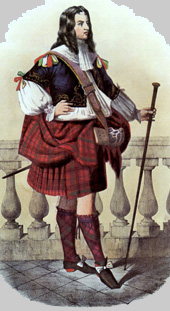- Clan Name: Robertson - .
- Clan Motto: Virtutis gloria merces = Glory is the reward of valour
- Clan Chief: Alexander Gilbert Haldane Robertson of Struan, 24th Chief of Clan Donnachaidh, 28th of Struan.
- Clan Lands: Struan, Rannoch, Perthshire Scotland
- Clan Tartan : Red Modern sett
- Clan links : Clan Donnachaidh
- Clan links :
Clan History
The Robertson family is said to be one of the oldest in Scotland. Claiming descent from Crinan who was the Laird of Atholl and hereditary lay Abbott of Dunkeld who married Bethoc, the daughter of Malcolm II. Their son became Duncan I, Scottish king from 1034 to 1040.
This period in history saw a lot of claims and counter claims as the map of Scotland was being forged uniting smaller kingdoms. Each Royal family fought for their right to rule. When King Alexander 3rd fell from his horse down the cliffs at Kinghorn, in 1286, and died with no surviving heir this developed into the Wars of the Succession.
Over the next ten years King John Balliol, supported by the English took the throne at Scone. William Wallace, Robert the Bruce and war with England all came to the fore.
Donnachaidh Reamhair nicknamed as Stout Duncan also gets a mention as the first recognised chief of the Clann Dhònnchaidh and took his men to Bannockburn to fight for Bruce. Duncan later fell into English hands at the battle of Neville's Cross in 1346. He died in 1355.
The succeeding clan chiefs were known as Duncanson son of Duncan in his honour.
Robert Duncanson, stout Duncan's grandson, was the fourth chief. He captured Sir Robert Graham and the Earl of Atholl, Walter Stewart. They had plotted and killed King James the 1st in 1437. As a token of gratitude and warning to all Robert was given the symbol of the hand and the crown to display on his crest by King James 2nd. Also under his shield was added a naked man in chains, representing the Regicide. He was later to be rewarded by elevating his lands into the Barony of Struan in 1451.
In 1460 Robert died as a result of wound received in a skirmish over lands at Dunkeld. He was succeeded by his son Alexander
Duncanson who being the son of Robert became known as Robertson. This was to end up as the line Robertson of Struan.
Robert's brother Patrick was ancestor of the principle cadet line, House of Lude.
Lude house is a country house that dominates the skyline at Blair Atholl, it was elevated to a Barony in 1448. An amusing anecdote concerning Lady Lude, in 1745 she held a ball in Lude house for Bonnie Prince Charlie who was over-nighting at Blair Castle. She was infatuated with the Prince and was described as behaving like a "light giglet" in his presence.
Alexander's grandson, William the 6th chief, was killed in 1530 trying to recover lands seized by their neighbours the Stewarts of Atholl.
In 1636 the chieftainship passed to Alexander who was at that time an infant. The leadership was passed to his uncle Donald in the mean-time. Donald was a staunch adherent to the Royalist cause. In 1646 he with 800 men from the Robertson clan joined the army of the Marques of Montrose. Montrose commissioned him Colonel in June 1646. The Robertsons played a big part in the route of Argyll at the Battle of Inverlochy.
Later under Alexander, when he came of age, they were also to take part in the Jacobite uprisings of 1689, 1715 and 1745.
After Culloden, which saw 400 Robertsons fighting under Lord Murray's Atholl Brigade the remaining lands that
had not been forfeited were seized as punishment. The clan was scattered.
The chieftainship passed to Duncan Robertson of Drumachuine but he could not attempt to recover any lands as he himself was outlawed for his part in the 1745 uprising.
His son Alexander, the 15th chief, had the Barony of Struan restored to him by the crown in 1784.
The following 80 years saw the highland clearances where people were thrown out of their houses and the areas were being cleared for sheep. The Robertson lands did not follow that strategy. Whether because of that or just the general post-Culloden actions and taxation by the government, the lands ended up getting sold off piece by piece to meet debts.
The main Robertson castle was at Invervack, near the present Clan museum, it was burned by Cromwell’s forces during the Civil War.
Two other fortifications that served the clan and worth a mention are Port an Eilein (fort on the island) and Eilean nam Faoileag (the island of gulls). They were both Crannogs, which is either man made islands or man enhanced islands.
Port an Eilein is located in the northwest corner of Loch Tummell and it is recorded that Stout Duncan built a strong house and garden on it. The man assisted island is now submerged as the loch level has been raised but diving expeditions have noted timbers and flagstones dating as recent as 1840. The "island" is 3 metres under the surface and surrounded by deep water.
Eilean nam Faoileag on Loch Rannoch is still visible today although much is below the water-line as the level has been raised 2 metres recently. It is believed that when King Robert the Bruce captured McDougall of Lorn, at the beginning of the 14th century, he entrusted him into the care of Stout Duncan who imprisoned him at that time on the island. The island is a sandbank that has been built up with rocks, on a 2004 survey radio carbon dating on cut timbers returned dates of 1110 and 1290. The island was reached by a secret causeway that would have been about 1 metre below the surface at that time. Despite it's strong position it was captured by the MacGregor clan and also the Menzies during it's history. It was still in use by the Struan Robertsons in the 18th century as a prison for those who offended their chief. The tower that can be seen today was built as a folly in the 19th century and is meant to be a copy of the last fortification.
